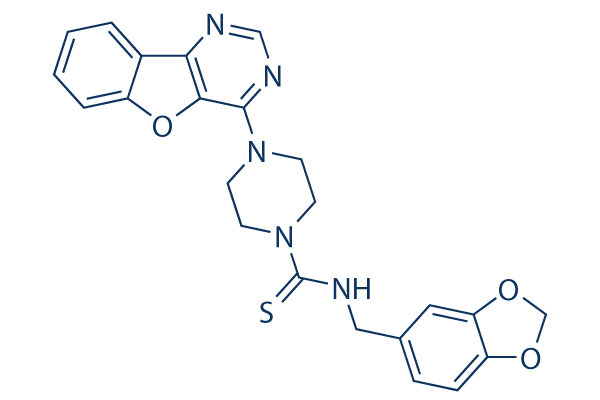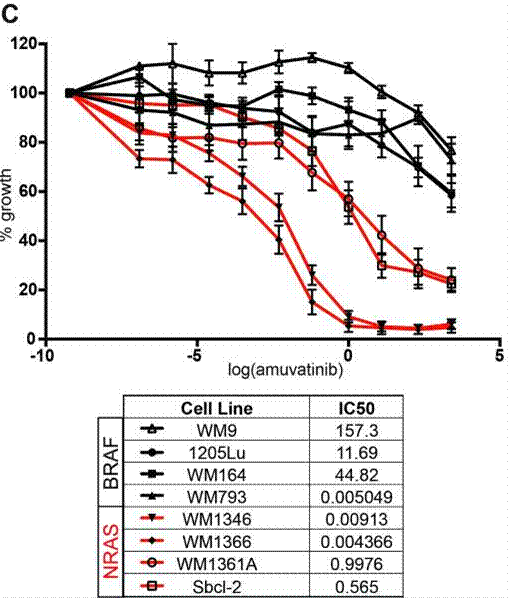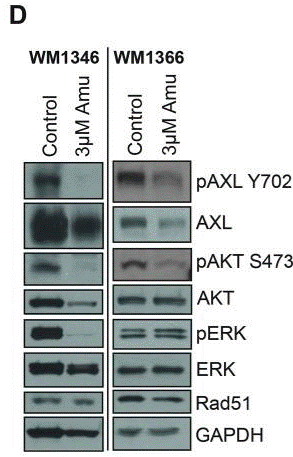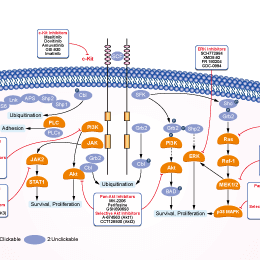
- Bioactive Compounds
- By Signaling Pathways
- PI3K/Akt/mTOR
- Epigenetics
- Methylation
- Immunology & Inflammation
- Protein Tyrosine Kinase
- Angiogenesis
- Apoptosis
- Autophagy
- ER stress & UPR
- JAK/STAT
- MAPK
- Cytoskeletal Signaling
- Cell Cycle
- TGF-beta/Smad
- DNA Damage/DNA Repair
- Compound Libraries
- Popular Compound Libraries
- Customize Library
- Clinical and FDA-approved Related
- Bioactive Compound Libraries
- Inhibitor Related
- Natural Product Related
- Metabolism Related
- Cell Death Related
- By Signaling Pathway
- By Disease
- Anti-infection and Antiviral Related
- Neuronal and Immunology Related
- Fragment and Covalent Related
- FDA-approved Drug Library
- FDA-approved & Passed Phase I Drug Library
- Preclinical/Clinical Compound Library
- Bioactive Compound Library-I
- Bioactive Compound Library-Ⅱ
- Kinase Inhibitor Library
- Express-Pick Library
- Natural Product Library
- Human Endogenous Metabolite Compound Library
- Alkaloid Compound LibraryNew
- Angiogenesis Related compound Library
- Anti-Aging Compound Library
- Anti-alzheimer Disease Compound Library
- Antibiotics compound Library
- Anti-cancer Compound Library
- Anti-cancer Compound Library-Ⅱ
- Anti-cancer Metabolism Compound Library
- Anti-Cardiovascular Disease Compound Library
- Anti-diabetic Compound Library
- Anti-infection Compound Library
- Antioxidant Compound Library
- Anti-parasitic Compound Library
- Antiviral Compound Library
- Apoptosis Compound Library
- Autophagy Compound Library
- Calcium Channel Blocker LibraryNew
- Cambridge Cancer Compound Library
- Carbohydrate Metabolism Compound LibraryNew
- Cell Cycle compound library
- CNS-Penetrant Compound Library
- Covalent Inhibitor Library
- Cytokine Inhibitor LibraryNew
- Cytoskeletal Signaling Pathway Compound Library
- DNA Damage/DNA Repair compound Library
- Drug-like Compound Library
- Endoplasmic Reticulum Stress Compound Library
- Epigenetics Compound Library
- Exosome Secretion Related Compound LibraryNew
- FDA-approved Anticancer Drug LibraryNew
- Ferroptosis Compound Library
- Flavonoid Compound Library
- Fragment Library
- Glutamine Metabolism Compound Library
- Glycolysis Compound Library
- GPCR Compound Library
- Gut Microbial Metabolite Library
- HIF-1 Signaling Pathway Compound Library
- Highly Selective Inhibitor Library
- Histone modification compound library
- HTS Library for Drug Discovery
- Human Hormone Related Compound LibraryNew
- Human Transcription Factor Compound LibraryNew
- Immunology/Inflammation Compound Library
- Inhibitor Library
- Ion Channel Ligand Library
- JAK/STAT compound library
- Lipid Metabolism Compound LibraryNew
- Macrocyclic Compound Library
- MAPK Inhibitor Library
- Medicine Food Homology Compound Library
- Metabolism Compound Library
- Methylation Compound Library
- Mouse Metabolite Compound LibraryNew
- Natural Organic Compound Library
- Neuronal Signaling Compound Library
- NF-κB Signaling Compound Library
- Nucleoside Analogue Library
- Obesity Compound Library
- Oxidative Stress Compound LibraryNew
- Plant Extract Library
- Phenotypic Screening Library
- PI3K/Akt Inhibitor Library
- Protease Inhibitor Library
- Protein-protein Interaction Inhibitor Library
- Pyroptosis Compound Library
- Small Molecule Immuno-Oncology Compound Library
- Mitochondria-Targeted Compound LibraryNew
- Stem Cell Differentiation Compound LibraryNew
- Stem Cell Signaling Compound Library
- Natural Phenol Compound LibraryNew
- Natural Terpenoid Compound LibraryNew
- TGF-beta/Smad compound library
- Traditional Chinese Medicine Library
- Tyrosine Kinase Inhibitor Library
- Ubiquitination Compound Library
-
Cherry Picking
You can personalize your library with chemicals from within Selleck's inventory. Build the right library for your research endeavors by choosing from compounds in all of our available libraries.
Please contact us at [email protected] to customize your library.
You could select:
- Antibodies
- Bioreagents
- qPCR
- 2x SYBR Green qPCR Master Mix
- 2x SYBR Green qPCR Master Mix(Low ROX)
- 2x SYBR Green qPCR Master Mix(High ROX)
- Protein Assay
- Protein A/G Magnetic Beads for IP
- Anti-Flag magnetic beads
- Anti-Flag Affinity Gel
- Anti-Myc magnetic beads
- Anti-HA magnetic beads
- Magnetic Separator
- Poly DYKDDDDK Tag Peptide lyophilized powder
- Protease Inhibitor Cocktail
- Protease Inhibitor Cocktail (EDTA-Free, 100X in DMSO)
- Phosphatase Inhibitor Cocktail (2 Tubes, 100X)
- Cell Biology
- Cell Counting Kit-8 (CCK-8)
- Animal Experiment
- Mouse Direct PCR Kit (For Genotyping)
- New Products
- Contact Us
Amuvatinib (MP-470)
Synonyms: HPK 56
Amuvatinib (MP-470, HPK 56) is a potent and multi-targeted inhibitor of c-Kit, PDGFRα and Flt3 with IC50 of 10 nM, 40 nM and 81 nM, respectively. Amuvatinib suppresses c-MET and c-RET. Amuvatinib is also active as a DNA repair protein Rad51 inhibitor with antineoplastic activity. Phase 2.

Amuvatinib (MP-470) Chemical Structure
CAS No. 850879-09-3
Purity & Quality Control
Batch:
Purity:
99.75%
99.75
Amuvatinib (MP-470) Related Products
| Related Products | Masitinib OSI-930 Sitravatinib (MGCD516) ISCK03 PDGFR inhibitor 1 | Click to Expand |
|---|---|---|
| Related Compound Libraries | Kinase Inhibitor Library Tyrosine Kinase Inhibitor Library PI3K/Akt Inhibitor Library Cell Cycle compound library Angiogenesis Related compound Library | Click to Expand |
Signaling Pathway
Cell Data
| Cell Lines | Assay Type | Concentration | Incubation Time | Formulation | Activity Description | PMID |
|---|---|---|---|---|---|---|
| GIST | Function assay | Inhibition of AXL in human GIST cells, IC50<1μM | 26555154 | |||
| DAOY | qHTS assay | qHTS of pediatric cancer cell lines to identify multiple opportunities for drug repurposing: Primary screen for DAOY cells | 29435139 | |||
| A673 | qHTS assay | qHTS of pediatric cancer cell lines to identify multiple opportunities for drug repurposing: Primary screen for A673 cells | 29435139 | |||
| SK-N-MC | qHTS assay | qHTS of pediatric cancer cell lines to identify multiple opportunities for drug repurposing: Primary screen for SK-N-MC cells | 29435139 | |||
| NB1643 | qHTS assay | qHTS of pediatric cancer cell lines to identify multiple opportunities for drug repurposing: Primary screen for NB1643 cells | 29435139 | |||
| LAN-5 | qHTS assay | qHTS of pediatric cancer cell lines to identify multiple opportunities for drug repurposing: Primary screen for LAN-5 cells | 29435139 | |||
| OHS-50 | qHTS assay | qHTS of pediatric cancer cell lines to identify multiple opportunities for drug repurposing: Primary screen for OHS-50 cells | 29435139 | |||
| Caco-2 | Function assay | 48 hrs | Determination of IC50 values for inhibition of SARS-CoV-2 induced cytotoxicity of Caco-2 cells after 48 hours by high content imaging, IC50=0.02μM | ChEMBL | ||
| Caco-2 | Function assay | 48 hrs | Toxicity against Caco-2 cells determined at 48 hours by intracellular ATP concentration using the CellTiter-Glo Luminescent Cell Viability Assay, CC50=0.06μM | ChEMBL | ||
| GIST882 | Function assay | 4 days | Inhibition of c-kit gain of function mutant in human GIST882 cells measured after 4 days by sulforhodamine B assay, IC50=1.6μM | ChEMBL | ||
| GIST882 | Function assay | 96 hrs | Inhibition of c-kit gain of function mutant in human GIST882 cells after 96 hrs by Cell-Titer Glo luciferase assay, IC50=1.6μM | ChEMBL | ||
| MIAPaCa2 | Function assay | 4 days | Inhibition of PDGFRA in human MIAPaCa2 cells measured after 4 days by sulforhodamine B assay, IC50=2.1μM | ChEMBL | ||
| PANC1 | Function assay | 4 days | Inhibition of PDGFRA in human PANC1 cells measured after 4 days by sulforhodamine B assay, IC50=3μM | ChEMBL | ||
| SF-767 | Cytotoxicity assay | 1 uM | 24 hrs | Cytotoxicity against human SF-767 cells assessed as cell death at 1 uM after 24 hrs by MTS assay | ChEMBL | |
| SF-767 | Cytotoxicity assay | 1 uM | 24 hrs | Cytotoxicity against human SF-767 cells assessed as cell death at 1 uM in presence of 800Gy ionizing radiation after 24 hrs by MTS assay | ChEMBL | |
| SBcl2 | Antitumor assay | 5 days | Antitumor activity against human SBcl2 cells xenografted in ip dosed athymic nude mouse assessed as reduction in tumor growth administered as qd for 5 days | ChEMBL | ||
| HT-29 | Function assay | Suppression of ionizing radiation-induced Rad51 expression in human HT-29 cells pretreated with compound followed by ionizing radiation by Western blot analysis | ChEMBL | |||
| Click to View More Cell Line Experimental Data | ||||||
Biological Activity
| Description | Amuvatinib (MP-470, HPK 56) is a potent and multi-targeted inhibitor of c-Kit, PDGFRα and Flt3 with IC50 of 10 nM, 40 nM and 81 nM, respectively. Amuvatinib suppresses c-MET and c-RET. Amuvatinib is also active as a DNA repair protein Rad51 inhibitor with antineoplastic activity. Phase 2. | |||||||||||
|---|---|---|---|---|---|---|---|---|---|---|---|---|
| Targets |
|
| In vitro | ||||
| In vitro | The hydrochloride salt of MP-470 also inhibits several mutants of c-Kit, including c-KitD816V, c-KitD816H, c-KitV560G, and c-KitV654A, as well as a Flt3 mutant (Flt3D835Y) and two PDGFRα mutants (PDGFRαV561D and PDGFRαD842V), with IC50 of 10 nM to 8.4 μM. MP-470 potently inhibits the proliferation of OVCAR-3, A549, NCI-H647, DMS-153, and DMS-114 cells, with IC50 of 0.9 μM–7.86 μM. [1] MP-470 also inhibits c-Kit and PDGFRα, with IC50 values of 31 μM and 27 μM, respectively. MP-470 demonstrates potent cytotoxicity against MiaPaCa-2, PANC-1, and GIST882 cells, with IC50 of 1.6 μM to 3.0 μM. MP-470 also binds to and inhibits several c-Kit mutants, including c-KitK642E, c-KitD816V, and c-KitK642E/D816V. [2] In MDA-MB-231 cells, MP-470 (1 μM) inhibits tyrosine phosphorylation of AXL. [3] In LNCaP and PC-3, but not DU145 cells, MP-470 exhibits cytotoxicity with IC50 of 4 μM and 8 μM, respectively, and induces apoptosis at 10 μM. In LNCaP cells, MP-470 (10 μM) elicits G1 arrest and decreases phosphorylation of Akt and ERK1/2. [4] In SF767 cells, MP-470 (10 μM) inhibits c-Met phosphorylation and sensitizes cells to radiation. In combination with radiation, MP-470 (10 μM) inhibits glycogen synthase kinase (GSK)3β activity, induces apoptosis, and disrupts the repair of dsDNA breaks probably through suppression of Rad51. [5] [6] |
|||
|---|---|---|---|---|
| Kinase Assay | Kinase inhibition assay of c-Kit and PDGFRα | |||
| For the testing of inhibitory activity against c-Kit and PDGFRα, enzymes are incubated with varying concentrations of MP-470 and radiolabeled γ-32P-ATP. After 30 min, the reaction mixtures are electrophoresed on an acrylamide gel and autophosphorylation, quantitated by the amount of radioactivity incorporated into the enzyme, is assayed. | ||||
| Cell Research | Cell lines | MiaPaCa-2, PANC-1, and GIST882 cells | ||
| Concentrations | 0–30 μM, dissolved in DMSO | |||
| Incubation Time | 96 hours | |||
| Method | Cells are plated at a density of 2 × 103 to 1 × 104 cells per well in 100 μL medium on day 0 in 96-well Falcon microtitier plates. On day 1, ten μL of serial dilutions of MP-470 are added to the plates in quadruplicates. After incubation for 4 days, the cells are fixed with 10% Trichloroacetic acid solution. Subsequently, they are labeled with 0.04% Sulforhodamine B (SRB) in 1% acetic acid. After multiple washes to remove the excess dye, 100 μL of 50 mM Tris solution is added to each well in order to dissolve the dye. The absorbance of each well is read on a plate reader at 570 nm. Date are expressed as the percentage of survival of control calculated from the absorbance corrected for background absorbance. The surviving percent of cells is determined by dividing the mean absorbance values of the monoclonal antibody by mean absorbance values of the control and multiplying by 100. |
|||
| Experimental Result Images | Methods | Biomarkers | Images | PMID |
| Growth inhibition assay | Cell viability |

|
24950457 | |
| Western blot | p-AXL / AXL / p-AKT / AKT / ERK / Rad51 |

|
24950457 | |
| In Vivo | ||
| In vivo | In mice xenograft models of HT-29, A549, and SB-CL2 cells, MP-470 (10 mg/kg–75 mg/kg via i.p. or 50 mg/kg–200 mg/kg via p.o.) inhibits tumor growth. [1] In mice bearing LNCaP xenograft, MP-470 (20 mg/kg) combined with Erlotinib significantly induces tumor growth inhibition (TGI). [4] |
|
|---|---|---|
| Animal Research | Animal Models | Mice (athymic nude) xenograft models of HT-29, A549, and SB-CL2 cells |
| Dosages | 10 mg/kg–75 mg/kg (i.p.) or 50 mg/kg–200 mg/kg (p.o.) | |
| Administration | Oral gavage (qd5 × 3 weeks) or intraperitoneal injection (qd5 × 2 weeks) | |
| NCT Number | Recruitment | Conditions | Sponsor/Collaborators | Start Date | Phases |
|---|---|---|---|---|---|
| NCT01357395 | Completed | Small Cell Lung Carcinoma |
Astex Pharmaceuticals Inc. |
May 2011 | Phase 2 |
Chemical Information & Solubility
| Molecular Weight | 447.51 | Formula | C23H21N5O3S |
| CAS No. | 850879-09-3 | SDF | Download Amuvatinib (MP-470) SDF |
| Smiles | C1CN(CCN1C2=NC=NC3=C2OC4=CC=CC=C43)C(=S)NCC5=CC6=C(C=C5)OCO6 | ||
| Storage (From the date of receipt) | |||
|
In vitro |
DMSO : 32 mg/mL ( (71.5 mM) Moisture-absorbing DMSO reduces solubility. Please use fresh DMSO.) Water : Insoluble Ethanol : Insoluble |
Molecular Weight Calculator |
|
In vivo Add solvents to the product individually and in order. |
In vivo Formulation Calculator |
||||
Preparing Stock Solutions
Molarity Calculator
In vivo Formulation Calculator (Clear solution)
Step 1: Enter information below (Recommended: An additional animal making an allowance for loss during the experiment)
mg/kg
g
μL
Step 2: Enter the in vivo formulation (This is only the calculator, not formulation. Please contact us first if there is no in vivo formulation at the solubility Section.)
% DMSO
%
% Tween 80
% ddH2O
%DMSO
%
Calculation results:
Working concentration: mg/ml;
Method for preparing DMSO master liquid: mg drug pre-dissolved in μL DMSO ( Master liquid concentration mg/mL, Please contact us first if the concentration exceeds the DMSO solubility of the batch of drug. )
Method for preparing in vivo formulation: Take μL DMSO master liquid, next addμL PEG300, mix and clarify, next addμL Tween 80, mix and clarify, next add μL ddH2O, mix and clarify.
Method for preparing in vivo formulation: Take μL DMSO master liquid, next add μL Corn oil, mix and clarify.
Note: 1. Please make sure the liquid is clear before adding the next solvent.
2. Be sure to add the solvent(s) in order. You must ensure that the solution obtained, in the previous addition, is a clear solution before proceeding to add the next solvent. Physical methods such
as vortex, ultrasound or hot water bath can be used to aid dissolving.
Tech Support
Answers to questions you may have can be found in the inhibitor handling instructions. Topics include how to prepare stock solutions, how to store inhibitors, and issues that need special attention for cell-based assays and animal experiments.
Tel: +1-832-582-8158 Ext:3
If you have any other enquiries, please leave a message.
* Indicates a Required Field
Tags: buy Amuvatinib (MP-470) | Amuvatinib (MP-470) supplier | purchase Amuvatinib (MP-470) | Amuvatinib (MP-470) cost | Amuvatinib (MP-470) manufacturer | order Amuvatinib (MP-470) | Amuvatinib (MP-470) distributor







































